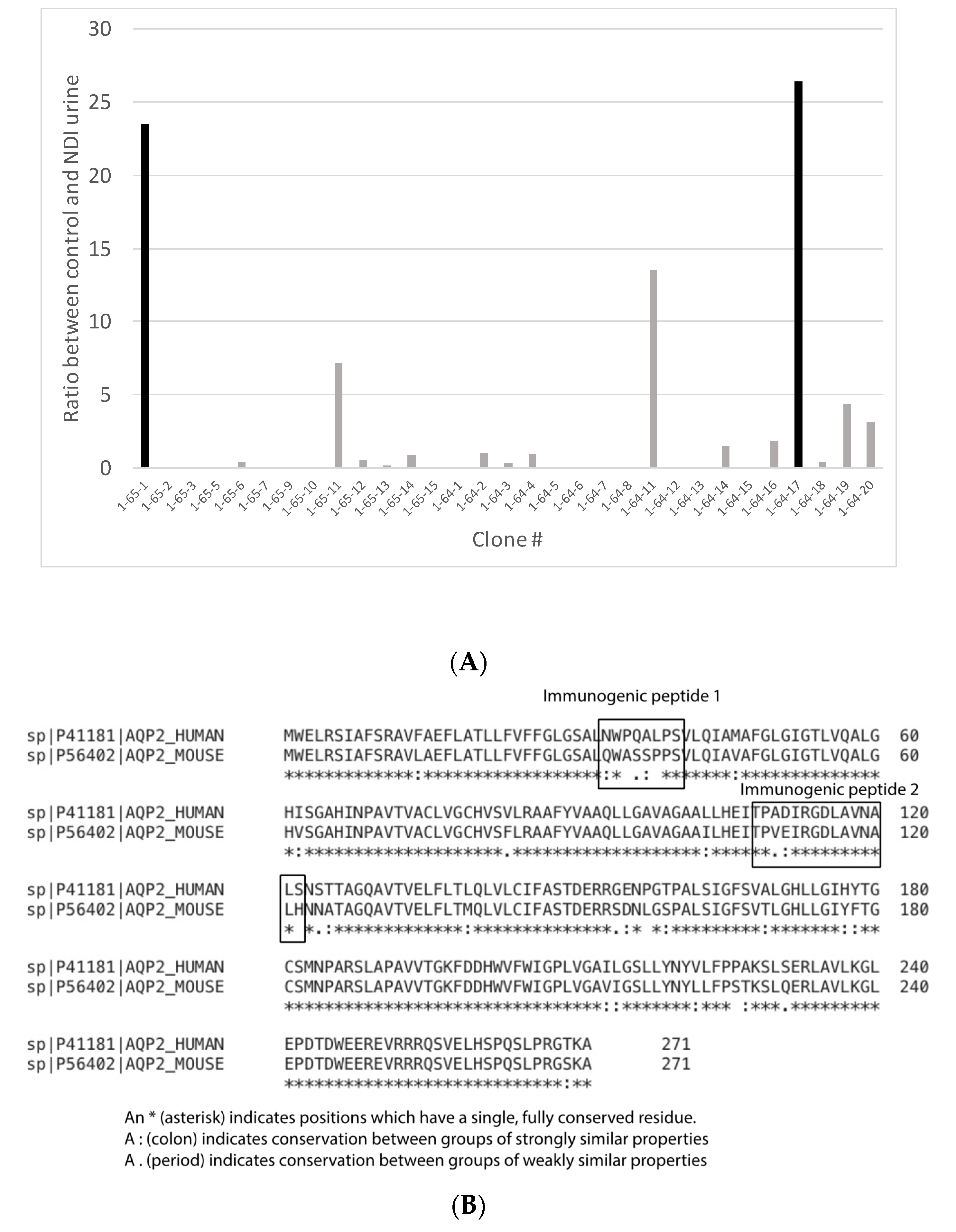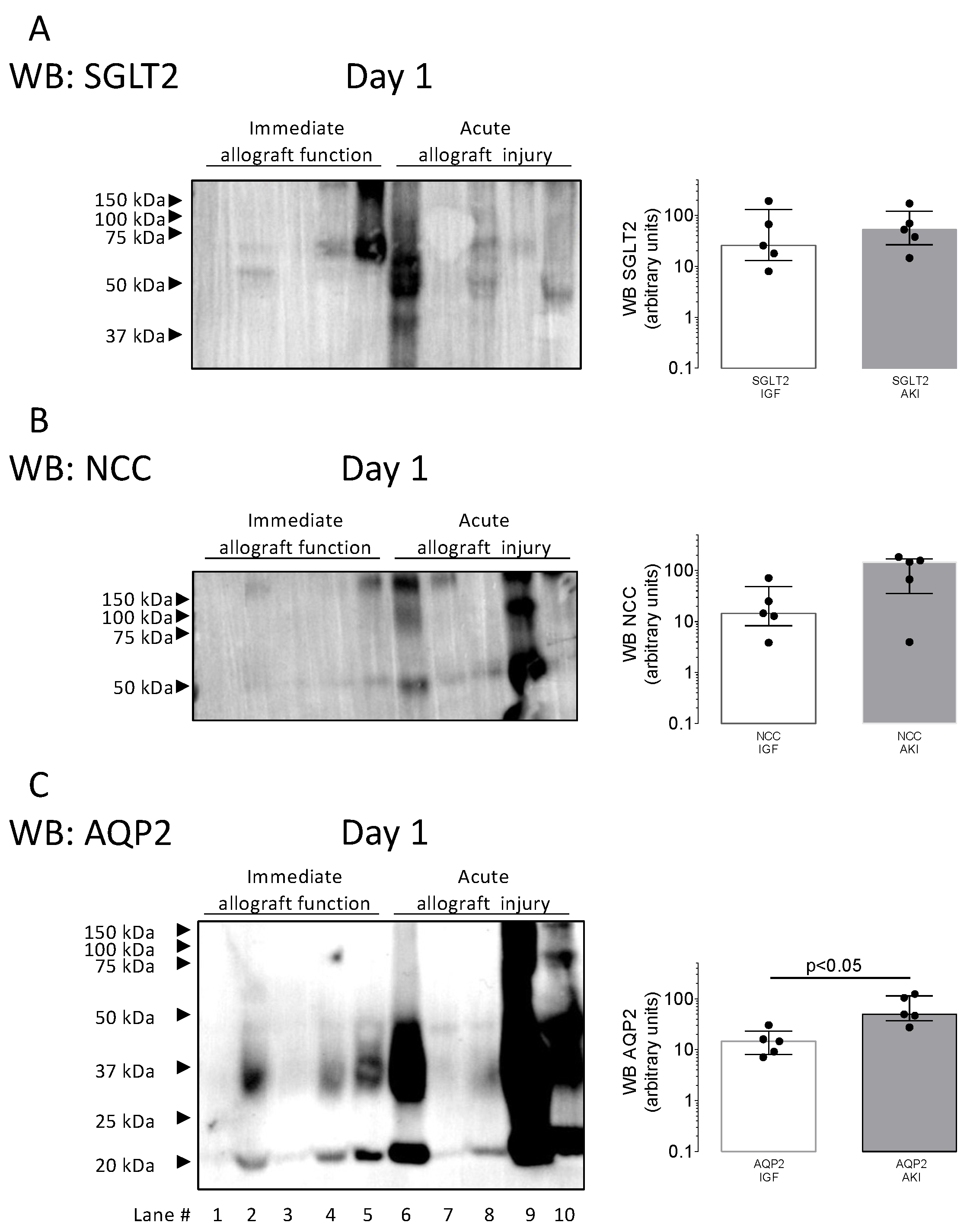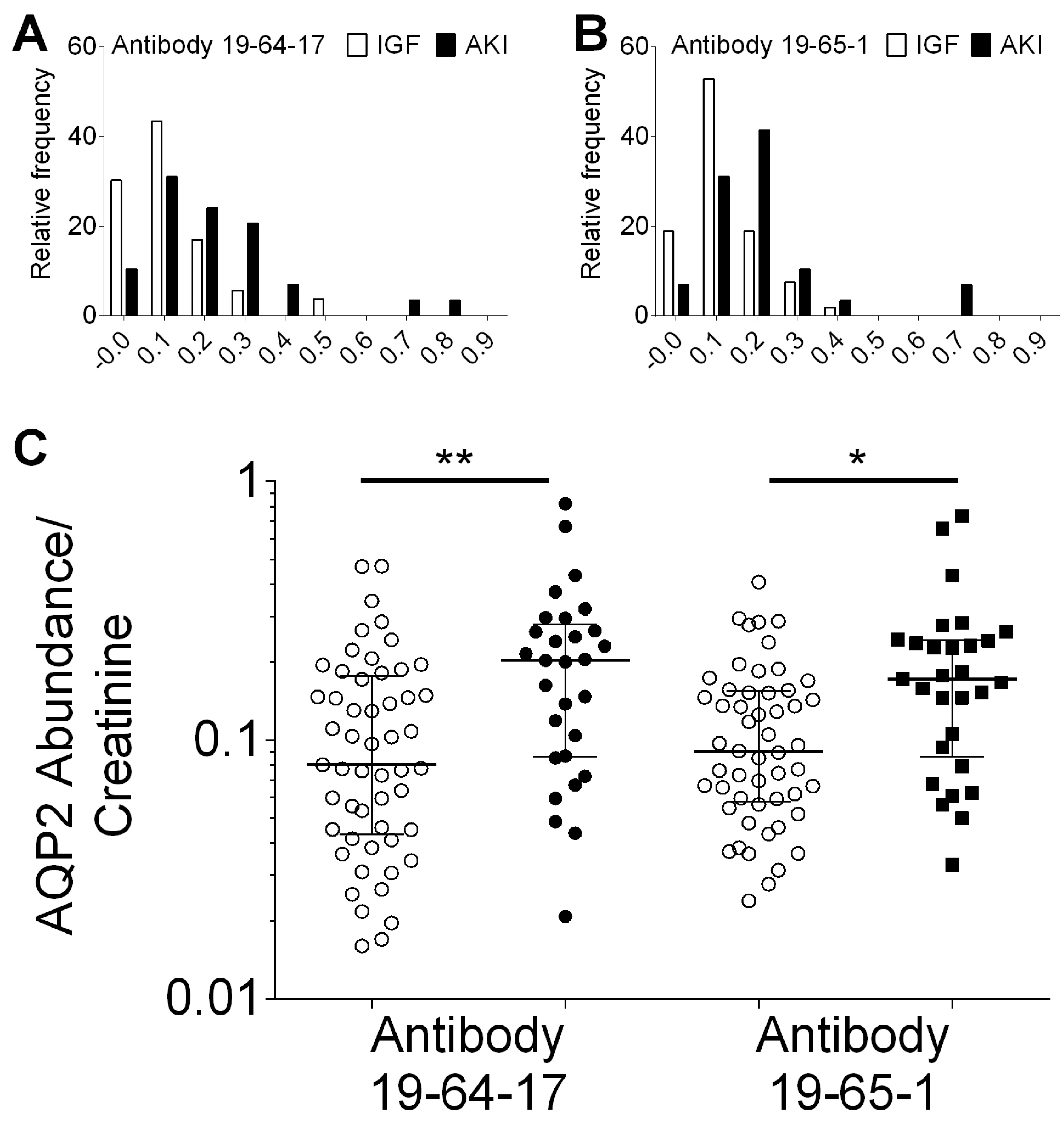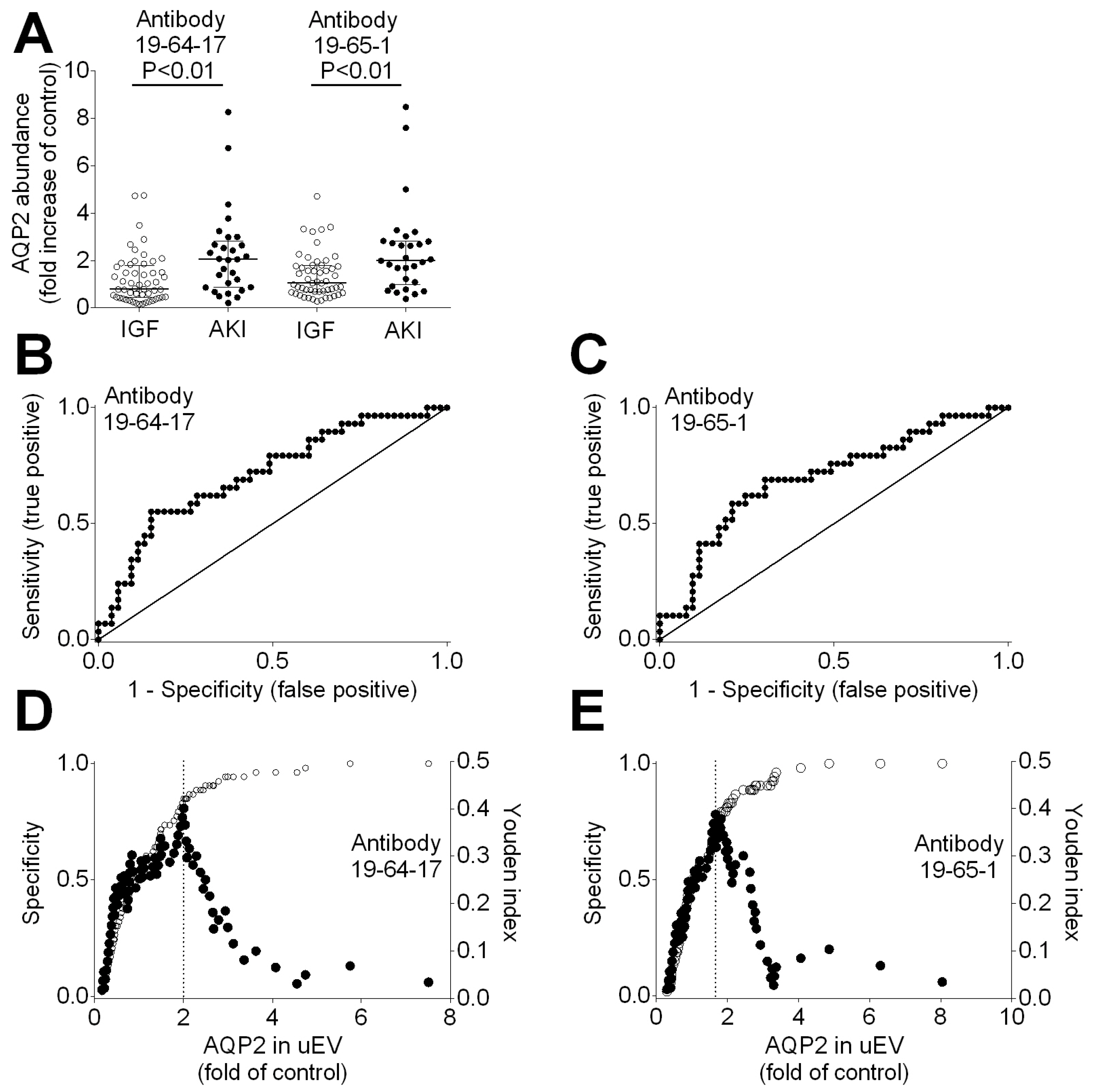Urinary Extracellular Vesicles for Non-Invasive Quantification of Principal Cell Damage in Kidney Transplant Recipients
Abstract
1. Introduction
2. Materials and Methods
2.1. Study Design, Discovery and Validation Cohorts, and Ethical Statements
2.2. Isolation of Urinary Extracellular Vesicles
2.3. Urinary Creatinine
2.4. Western Blotting
2.5. Production and Cloning of Monoclonal Anti-Aqp2 Antibodies
2.6. Enzyme-Linked Immunosorbent Assay (ELISA)
2.7. Outcome Variables
2.8. Statistical Analyses
3. Results
3.1. Identification of uEVs in Post-Transplant Urine in the Discovery Cohort Using Western Blotting
3.2. Comparison of uEV Abundance from Several Epithelial Sources in the Allograft
3.3. Characteristics of Kidney Transplant Recipients in the Validation Cohort
3.4. Acute Kidney Injury after Transplantation
3.5. AQP2 Abundance in uEVs Determines Acute Kidney Injury Post-Transplant
3.6. AQP2 Abundance in uEVs Indicates Damage of Principal Cell Post-Transplant
4. Discussion
Supplementary Materials
Author Contributions
Funding
Institutional Review Board Statement
Informed Consent Statement
Data Availability Statement
Conflicts of Interest
References
- Johnston, O.; O’Kelly, P.; Spencer, S.; Donohoe, J.; Walshe, J.J.; Little, D.M.; Hickey, D.; Conlon, P.J. Reduced graft function (with or without dialysis) vs immediate graft function--A comparison of long-term renal allograft survival. Nephrol. Dial. Transplant. 2006, 21, 2270–2274. [Google Scholar] [CrossRef]
- Siedlecki, A.; Irish, W.; Brennan, D.C. Delayed graft function in the kidney transplant. Am. J. Transplant. 2011, 11, 2279–2296. [Google Scholar] [CrossRef]
- Aranda-Rivera, A.K.; Cruz-Gregorio, A.; Pedraza-Chaverri, J.; Scholze, A. Nrf2 Activation in Chronic Kidney Disease: Promises and Pitfalls. Antioxidants 2022, 11, 1112. [Google Scholar] [CrossRef] [PubMed]
- Rasmussen, M.; Hansen, K.H.; Scholze, A. Nrf2 Protein Serum Concentration in Human CKD Shows a Biphasic Behavior. Antioxidants 2023, 12, 932. [Google Scholar] [CrossRef] [PubMed]
- Nagarajah, S.; Rasmussen, M.; Hoegh, S.V.; Tepel, M. Prospective Study of Long Noncoding RNA, MGAT3-AS1, and Viremia of BK Polyomavirus and Cytomegalovirus in Living Donor Renal Transplant Recipients. Kidney Int. Rep. 2020, 5, 2218–2227. [Google Scholar] [CrossRef]
- Tepel, M.; Alkaff, F.F.; Kremer, D.; Bakker, S.J.L.; Thaunat, O.; Nagarajah, S.; Saleh, Q.; Berger, S.P.; van den Born, J.; Krogstrup, N.V.; et al. Pretransplant endotrophin predicts delayed graft function after kidney transplantation. Sci. Rep. 2022, 12, 4079. [Google Scholar] [CrossRef]
- Saleh, Q.W.; Mohammadnejad, A.; Tepel, M. Lower levels of FOXP3 are associated with prolonged inflammatory responses in kidney transplant recipients. Front. Immunol. 2023, 14, 1252857. [Google Scholar] [CrossRef] [PubMed]
- Luo, Z.; Zhang, Y.; Saleh, Q.W.; Zhang, J.; Zhu, Z.; Tepel, M. Metabolic regulation of forkhead box P3 alternative splicing isoforms and their impact on health and disease. Front. Immunol. 2023, 14, 1278560. [Google Scholar] [CrossRef] [PubMed]
- Cooper, J.E.; Wiseman, A.C. Acute kidney injury in kidney transplantation. Curr. Opin. Nephrol. Hypertens. 2013, 22, 698–703. [Google Scholar] [CrossRef]
- Asvapromtada, S.; Sonoda, H.; Kinouchi, M.; Oshikawa, S.; Takahashi, S.; Hoshino, Y.; Sinlapadeelerdkul, T.; Yokota-Ikeda, N.; Matsuzaki, T.; Ikeda, M. Characterization of urinary exosomal release of aquaporin-1 and -2 after renal ischemia-reperfusion in rats. Am. J. Physiol. Renal Physiol. 2018, 314, F584–F601. [Google Scholar] [CrossRef]
- Shah, R.; Patel, T.; Freedman, J.E. Circulating Extracellular Vesicles in Human Disease. N. Engl. J. Med. 2018, 379, 958–966. [Google Scholar] [CrossRef]
- Svenningsen, P.; Sabaratnam, R.; Jensen, B.L. Urinary extracellular vesicles: Origin, role as intercellular messengers and biomarkers; efficient sorting and potential treatment options. Acta Physiol. 2020, 228, e13346. [Google Scholar] [CrossRef]
- Street, J.M.; Birkhoff, W.; Menzies, R.I.; Webb, D.J.; Bailey, M.A.; Dear, J.W. Exosomal transmission of functional aquaporin 2 in kidney cortical collecting duct cells. J. Physiol. 2011, 589, 6119–6127. [Google Scholar] [CrossRef]
- Senda, A.; Kojima, M.; Watanabe, A.; Kobayashi, T.; Morishita, K.; Aiboshi, J.; Otomo, Y. Profiles of lipid, protein and microRNA expression in exosomes derived from intestinal epithelial cells after ischemia-reperfusion injury in a cellular hypoxia model. PLoS ONE 2023, 18, e0283702. [Google Scholar] [CrossRef]
- Auber, M.; Svenningsen, P. An estimate of extracellular vesicle secretion rates of human blood cells. J. Extracell. Biol. 2022, 1, e46. [Google Scholar] [CrossRef] [PubMed]
- Auglienė, R.; Dalinkevičienė, E.; Kuzminskis, V.; Maslauskienė, R.; Bumblytė, I.A. Early Kidney Graft Loss: Etiology and Risk. Medicina 2017, 53, 66–71. Available online: https://hdl.handle.net/20.500.12512/19646 (accessed on 23 August 2024).
- Erdbrügger, U.; Blijdorp, C.J.; Bijnsdorp, I.V.; Borràs, F.E.; Burger, D.; Bussolati, B.; Byrd, J.B.; Clayton, A.; Dear, J.W.; Falcón-Pérez, J.M.; et al. Urinary extracellular vesicles: A position paper by the Urine Task Force of the International Society for Extracellular Vesicles. J. Extracell. Vesicles 2021, 10, e12093. [Google Scholar] [CrossRef] [PubMed]
- Sabaratnam, R.; Geertsen, L.; Skjødt, K.; Højlund, K.; Dimke, H.; Lund, L.; Svenningsen, P. In human nephrectomy specimens, the kidney level of tubular transport proteins does not correlate with their abundance in urinary extracellular vesicles. Am. J. Physiol.-Ren. Physiol. 2019, 317, F560–F571. [Google Scholar] [CrossRef] [PubMed]
- Zachar, R.; Jensen, B.L.; Svenningsen, P. Dietary Na+ intake in healthy humans changes the urine extracellular vesicle prostasin abundance while the vesicle excretion rate, NCC, and ENaC are not altered. Am. J. Physiol.-Ren. Physiol. 2019, 317, F1612–F1622. [Google Scholar] [CrossRef]
- Schindelin, J.; Arganda-Carreras, I.; Frise, E.; Kaynig, V.; Longair, M.; Pietzsch, T.; Preibisch, S.; Rueden, C.; Saalfeld, S.; Schmid, B.; et al. Fiji: An open-source platform for biological-image analysis. Nat. Methods 2012, 9, 676–682. [Google Scholar] [CrossRef]
- Garcia-Martin, R.; Brandao, B.B.; Thomou, T.; Altindis, W.; Kahn, C.R. Tissue differences in the exosomal/small extracellular vesicle proteome and their potential as indicators of altered tissue metabolism. Cell Rep. 2022, 38, 110277. [Google Scholar] [CrossRef] [PubMed]
- Wu, W.K.; Famure, O.; Li, Y.; Kim, S.J. Delayed graft function and the risk of acute rejection in the modern era of kidney transplantation. Kidney Int. 2015, 88, 851–858. [Google Scholar] [CrossRef]
- Mogulla, M.R.; Bhattacharjya, S.; Clayton, P.A. Risk factors for and outcomes of delayed graft function in live donor kidney transplantation—A retrospective study. Transpl. Int. 2019, 32, 1151–1160. [Google Scholar] [CrossRef] [PubMed]
- Bazzell, G.; Rainey, W.E.; Auchus, R.J.; Zocco, D.; Bruttini, M.; Hummel, S.L.; Byrd, J.B. Human urinary mRNA as a biomarker of cardiovascular disease. Circ. Genom. Precis. Med. 2018, 11, e002213. [Google Scholar] [CrossRef] [PubMed]
- Gonzales, P.A.; Pisitkun, T.; Hoffert, L.D.; Tchapyjnikov, D.; Star, R.A.; Kleta, R.; Wang, N.S.; Knepper, M.A. Large-scale proteomics and phosphoproteomics of urinary exosomes. J. Am. Soc. Nephrol. 2009, 20, 363–379. [Google Scholar] [CrossRef]
- Miranda, K.C.; Bond, D.T.; McKee, M.; Skog, J.; Păunescu, T.G.; Da Silva, N.; Brown, D.; Russo, L.M. Nucleic acids within urinary exosomes/microvesicles are potential biomarkers for renal disease. Kidney Int. 2010, 78, 191–199. [Google Scholar] [CrossRef]
- Spanu, S.; van Roeyen, C.R.C.; Denecke, B.; Floege, J.; Mühlfeld, A.S. Urinary exosomes: A novel means to non-invasively assess changes in renal gene and protein expression. PLoS ONE 2014, 9, e109631. [Google Scholar] [CrossRef]
- Cavallari, C.; Ranghino, A.; Tapparo, M.; Cedrino, M.; Figliolini, F.; Grange, C.; Giannachi, V.; Garneri, P.; Deregibus, M.C.; Collino, F.; et al. Serum-derived extracellular vesicles (EVs) impact on vascular remodeling and prevent muscle damage in acute hind limb ischemia. Sci. Rep. 2017, 7, 8180. [Google Scholar] [CrossRef]
- Koh, Y.Q.; Peiris, H.N.; Vaswani, K.; Reed, S.; Rice, G.E.; Salomon, C.; Mitchell, M.D. Characterization of exosomal release in bovine endometrial intercaruncular stromal cells. Reprod. Biol. Endocrinol. 2016, 14, 78. [Google Scholar] [CrossRef]
- Chan, M.Y.; Chen, Y.C.; Fan, P.C.; Lee, C.C.; Kou, G.; Chang, C.H. Predictive Value of Urinary Aquaporin 2 for Acute Kidney Injury in Patients with Acute Decompensated Heart Failure. Biomedicines 2022, 10, 613. [Google Scholar] [CrossRef]







| All Patients (N = 16) | Acute Allograft Injury (N = 7) | Immediate Kidney Function (N = 9) | p-Value | |
|---|---|---|---|---|
| Age of recipient (years) | 48 (43–63) | 49 (44–60) | 47 (44–67) | 0.98 |
| Recipient gender male, N (%) | 11 (69%) | 5 (71%) | 6 (67%) | 1.00 |
| Body weight (kg) | 78 (68–98) | 70 (65–107) | 80 (70–98) | 0.96 |
| Body mass index (kg/m2) | 24.7 (23.0–30.9) | 24.3 (22.3–31.9) | 25.0 (23.3–29.5) | 0.80 |
| Systolic blood pressure (mmHg) | 146 (120–177) | 126 (110–165) | 150 (135–177) | 0.42 |
| Diastolic blood pressure (mmHg) | 80 (76–90) | 80 (72–85) | 81 (78–90) | 0.42 |
| Hypertension, N (%) | 15 (94%) | 7 (100%) | 8 (89%) | 1.00 |
| Smoking, N (%) | 4 (25%) | 1 (14%) | 3 (33%) | 0.48 |
| Cardiovascular disease, N (%) | 2 (13%) | 1 (14%) | 1 (11%) | 1.00 |
| Dialysis, N (%) | 1.00 | |||
| Hemodialysis | 12 (75%) | 5 (71%) | 7 (78%) | |
| Peritoneal dialysis | 3 (19%) | 2 (29%) | 1 (11%) | |
| Preemptive | 1 (6%) | 0 (0%) | 1 (11%) | |
| Dialysis vintage (months) | 18 (12–36) | 12 (12–28) | 24 (10–46) | 0.74 |
| Anuric before transplant, N (%) | 7 (44%) | 4 (57%) | 3 (33%) | 0.61 |
| Medication, N (%) Angiotensin converting enzyme inhibitor | 3 (19%) | 2 (29%) | 1 (11%) | 0.50 |
| Angiotensin receptor blocker | 3 (19%) | 1 (14%) | 2 (22%) | 1.00 |
| Beta receptor blocker | 6 (38%) | 1 (14%) | 5 (56%) | 0.14 |
| Diuretics | 7 (44%) | 3 (43%) | 4 (44%) | 1.00 |
| Age of the donor (years) | 53 (48–68) | 67 (53–71) | 49 (31–56) | 0.05 |
| Donor gender female, N (%) | 6 (38%) | 2 (29%) | 4 (44%) | 0.63 |
| Number of HLA mismatches (range) c | 4 (4–5) | 4 (4–5) | 5 (4–5) | 0.47 |
| Cold ischemic time (min) | 810 (658–1155) | 900 (600–1155) | 810 (723–1073) | 0.93 |
| Plasma creatinine pretransplant (µmol/L) | 713 (598–960) | 940 (749–1025) | 924 (545–713) | 0.12 |
| Induction therapy, N (%) Basiliximab Thymoglobulin | 14 (88%) 2 (12%) | 6 (86%) 1 (14%) | 8 (89%) 1 (11%) | 1.00 1.00 |
| All Patients (N = 82) | Acute Allograft Injury (N = 29) | Immediate Kidney Function (N = 53) | p-Value | |
|---|---|---|---|---|
| Age of recipient (years) | 50 (43–57) | 54 (43–57) | 50 (41–58) | 0.54 |
| Recipient gender male, N (%) | 43 (32%) | 17 (59%) | 26 (49%) | 0.49 |
| Body weight (kg) | 71 (61–85) | 73 (64–82) | 70 (60–85) | 0.75 |
| Body mass index (kg/m2) | 24.8 (21.2–27.5) | 25.0 (22.1–27.7) | 24.4 (20.8–274) | 0.72 |
| Systolic blood pressure (mmHg) | 141 (130–160) | 146 (140–160) | 140 (130– 160) | 0.55 |
| Diastolic blood pressure (mmHg) | 87 (79–92) | 90 (80–97) | 82 (75–90) | 0.30 |
| Cause of kidney disease, N (%) | 0.37 | |||
| Glomerulo- nephritis | 36 (44%) | 10 (34%) | 26 (49%) | |
| Diabetes mellitus | 13 (16%) | 4 (14%) | 9 (17%) | |
| Hypertension | 9 (11%) | 5 (17%) | 4 (8%) | |
| Interstitial nephritis | 4 (5%) | 3 (10%) | 1 (2%) | |
| Polycystic kidney disease | 9 (11%) | 3 (10%) | 6 (11%) | |
| Other / Unknown | 11 (13%) | 4 (14%) | 7 (13%) | |
| Hypertension, N (%) | 63 (77%) | 25 (86%) | 38 (72%) | 0.17 |
| Smoking, N (%) | 11 (13%) | 3 (10%) | 8 (15%) | 0.74 |
| Cardiovascular disease, N | 18 (22%) | 10 (34%) | 8 (15%) | 0.05 |
| (%) | ||||
| Coronary artery | 14 (17%) | 8 (28%) | 6 (11%) | |
| disease | ||||
| Peripheral artery | 1 (1%) | 1 (3%) | 0 (0%) | |
| disease | ||||
| Stroke | 3 (4%) | 1 (3%) | 2 (4%) | |
| Dialysis, N (%) | 0.74 | |||
| Hemodialysis | 72 (88%) | 25 (86%) | 47 (89%) | |
| Peritoneal dialysis | 10 (12%) | 4 (14%) | 6 (11%) | |
| Dialysis vintage (months) | 25 (11–43) | 35 (12–61) | 23 (11–33) | 0.11 |
| Anuric before transplant, N (%) | 29 (35%) | 14 (48%) | 15 (28%) | 0.09 |
| Medication, N (%) Angiotensin converting enzyme inhibitor | 14 (17%) | 5 (17%) | 9 (17%) | 1.00 |
| Angiotensin receptor blocker | 26 (23%) | 11 (38%) | 15 (28%) | 0.45 |
| Beta receptor blocker | 40 (49%) | 17 (59%) | 23 (43%) | 0.25 |
| Diuretics | 16 (20%) | 7 (24%) | 9 (17%) | 0.56 |
| Age of the donor (years) | 47 (37–61) | 50 (40–65) | 46 (32–57) | 0.20 |
| Donor gender female, N (%) | 34 (41%) | 14 (48%) | 20 (38%) | 0.48 |
| Number of HLA mismatches (range) c | 4 (3–4) | 4 (3–4) | 3 (3–4) | 0.31 |
| Cold ischemic time (min) | 840 (734–1020) | 960 (780–1140) | 806 (720–960) | 0.02 |
| Plasma creatinine pretransplant, (µmol/L) | 756 (636–933) | 884 (729–1053) | 730 (614–885) | 0.01 |
| Induction therapy, N (%) Basiliximab Thymoglobulin | 77 (94%) 3 (4%) | 25 (86%) 1 (2%) | 52 (98%) 2 (3%) | 0.05 0.28 |
Disclaimer/Publisher’s Note: The statements, opinions and data contained in all publications are solely those of the individual author(s) and contributor(s) and not of MDPI and/or the editor(s). MDPI and/or the editor(s) disclaim responsibility for any injury to people or property resulting from any ideas, methods, instructions or products referred to in the content. |
© 2024 by the authors. Licensee MDPI, Basel, Switzerland. This article is an open access article distributed under the terms and conditions of the Creative Commons Attribution (CC BY) license (https://creativecommons.org/licenses/by/4.0/).
Share and Cite
Svenningsen, P.; Maslauskiene, R.; Palarasah, Y.; Bumblyte, I.A.; Tepel, M. Urinary Extracellular Vesicles for Non-Invasive Quantification of Principal Cell Damage in Kidney Transplant Recipients. Biomolecules 2024, 14, 1124. https://doi.org/10.3390/biom14091124
Svenningsen P, Maslauskiene R, Palarasah Y, Bumblyte IA, Tepel M. Urinary Extracellular Vesicles for Non-Invasive Quantification of Principal Cell Damage in Kidney Transplant Recipients. Biomolecules. 2024; 14(9):1124. https://doi.org/10.3390/biom14091124
Chicago/Turabian StyleSvenningsen, Per, Rima Maslauskiene, Yaseelan Palarasah, Inga A. Bumblyte, and Martin Tepel. 2024. "Urinary Extracellular Vesicles for Non-Invasive Quantification of Principal Cell Damage in Kidney Transplant Recipients" Biomolecules 14, no. 9: 1124. https://doi.org/10.3390/biom14091124
APA StyleSvenningsen, P., Maslauskiene, R., Palarasah, Y., Bumblyte, I. A., & Tepel, M. (2024). Urinary Extracellular Vesicles for Non-Invasive Quantification of Principal Cell Damage in Kidney Transplant Recipients. Biomolecules, 14(9), 1124. https://doi.org/10.3390/biom14091124







